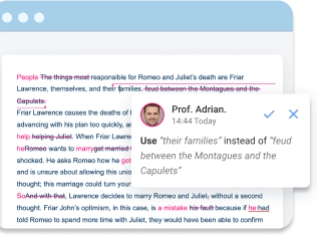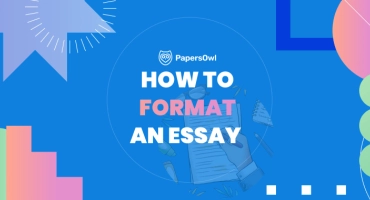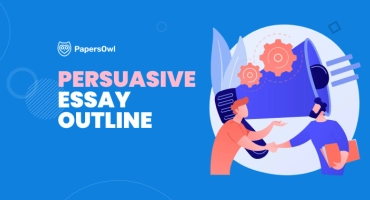How to Write a Character Analysis Essay
Table of contents
- 1 What Is a Character Analysis?
- 2 Quick How-To: 6 Steps
- 3 Character Types You’ll Reference
- 4 Thesis Toolkit
- 5 Evidence Toolkit: Using Quotes
- 6 Paragraph Model (TEEL) — Full Worked Example
- 7 Character Analysis Essay Examples
- 8 Character Analysis Essay Outline
- 9 Common Pitfalls & How to Fix Them
- 10 Quick Checklist for Students
- 11 Evaluation Rubric for a Character Analysis Essay
- 12 Summing Up
Working on essays can feel hard, but you are not alone. With PapersOwl writing service, you can see clear models and learn faster.
Below are short points to help you. Each is a guide to writing and character analysis examples that make sense for modern students. Use this section as your quick start before you build a full character analysis essay outline.
Key Takeaways:
- Start your essay with a short introduction that names the book and the character.
- Write a clear thesis statement that shows your focus.
- Use the outline to organize your main points discussed in order.
- Always analyze quotes instead of only summarizing.
- Keep your writing in the present tense and avoid plot retelling.
- Connect each idea to the story’s larger themes.
- Finish the essay with insight, not just a summary.
What Is a Character Analysis?
Many students ask about dialogue inside essays or summaries, but that is not the same as analysis. To succeed, you need to know what is a character analysis.
Character analysis is the study of a person in a book, film, or play. You examine their choices, growth, and role in the plot. The character analysis definition is simple: describe traits, actions, and relationships to see how they build meaning in the literature.
This method moves past the summary. It gives you a deeper understanding of the text and shows your skill in reading critically.
Here are some core ideas to guide your own literary work:
- link the introduction to the book and show why the character matters;
- explain how the character connects with other characters in the plot;
- explore examples from the Harry Potter series for clear models;
- show how the person’s choices reveal their relationships and values;
- connect each idea to broader lessons or themes.
Quick How-To: 6 Steps
If you have ever asked yourself how to write a character analysis essay, this section gives you a short plan. Students often feel lost when starting. But these six quick steps will help you do my essay for me faster.
- Write a clear character analysis essay introduction. State the book, author, and specific character you will discuss.
- Describe the character’s physical appearance. Simple details often lead to strong insights.
- Note the most important character traits. Use short words and clear reasoning.
- Show how the character’s relationships with other characters affect the story.
- Connect ideas to big themes in the Harry Potter series or any novel you study.
- Close your analysis essay with the main idea about growth, choices, or lessons.
Step 1: Re-read and Annotate with Purpose
Before learning how to start a character analysis essay, you must return to the text. Students who re-read carefully and take notes get stronger results. This process is part of character analysis in literature review and trains you to look deeper.
- Take detailed notes on your essay as you re-read.
- Focus on the writing style and what you can analyze.
- Track a dynamic character to see how they shift in meaning.
- Mark where the book links to art forms like poetry or film.
- Always think about relationships and the big idea of the story.
Step 2: Choose a Character with an Arc
Learning how to analyze a character starts with smart selection. Strong essays focus on characters who actually change. This improves your thinking and shows insight.
Even in poetry, as you might find in a writing a poetry essay task, character arcs give you rich material.
- Pick a dynamic character who grows or transforms.
- Avoid a static character unless you need contrast.
- Select your chosen character with care — it shapes your essay.
- Practice critical thinking skills while making this choice.
- Write in the present tense to keep the analysis sharp.
- Explore relationships as you trace the big idea of the book.
Step 3: Draft a Working Thesis
To analyze characteristics well, you need a clear claim. Your thesis is the engine of your paper. Students who skip this step lose direction. If it feels hard, remember you can buy essays online to see how others do it — but practice makes you stronger.
- Shape a strong thesis early.
- Make sure your thesis statement covers the main idea.
- Link your claim to the essay’s focus.
- Show the character’s personality in detail.
- Cover different aspects like motives, fears, and hopes.
- Tie your thesis to relationships and the book’s idea.
Step 4: Collect Evidence with the STEAL Table
Students need proof. The best way is to use the STEAL table. It gives you examples of character analysis by tracking Speech, Thoughts, Effect, Actions, and Looks. This makes your essay stronger and helps you stay clear in structure.
- Fill in body paragraphs using the STEAL method.
- Use your character analysis essay outline to organize notes.
- Focus on writing with specific examples from the text.
- Build each essay point around character traits that matter.
- Always link back to the literary piece you study.
- Show how relationships shape meaning and focus.
The STEAL method helps you organize character personality traits with direct proof from the text. As you re-read, place quotes into each category.
| Element | What to Track | Example (MLA style) |
| Speech | What the character says: tone, honesty, or bias | “I volunteer as tribute!” (Collins 22) → shows Katniss’s selflessness. |
| Thoughts | Inner reflections that reveal fears, hopes, or motives | “Gatsby bought that house so Daisy would be just across the bay” (Fitzgerald 78) → obsession with the past. |
| Effect on Others | How do other characters react to them | “The villagers looked up to Okonkwo as a strong man” (Achebe 29) → respect tied to masculinity. |
| Actions | Key deeds that define choices | “Atticus left the courtroom by the back door” (Lee 211) → quiet dignity despite loss. |
| Looks | Physical details or symbols tied to meaning | “Hamlet in black” (Shakespeare 1.2.80) → visual mark of grief and alienation. |
Step 5: Build TEEL/PEEL Body Paragraphs
A strong character analysis paper uses structure. TEEL or PEEL (Topic, Evidence, Explanation, Link) is a simple method. Students like it because it gives a formula for each paragraph.
- Structure body paragraphs with a clear idea.
- Keep your essay logical.
- Use it for any analysis essay you are writing.
- Support claims with examples.
- Show the character’s actions in context.
- Add background information only when needed.
- Always keep context and focus clear.
Step 6: Conclude with Insight
In the end, every paper must show character development in literature. A strong ending reveals not just the plot but the deeper message. If needed, you can look at samples or even buy essays online for study, but your voice matters most.
- Highlight the character change across the book.
- Explain how the character evolves with time.
- Link findings to broader themes like love, justice, or loss.
- Tie the whole essay to where the character stands now.
- Use figures like Hermione Granger as a clear example.
- Keep context in view and maintain strong focus.
Character Types You’ll Reference
When you create a character analysis essay, you need to know the types of characters you will meet in books and films. Students often mix roles, but knowing them gives context and focus.
For example, in the Harry Potter series, a main character like Harry works with other characters like Ron and Hermione. Even Hermione Granger shows how roles shape the theme of the story.
- Protagonist: central figure (e.g., Katniss in The Hunger Games).
- Antagonist: opposes the protagonist (e.g., Voldemort in Harry Potter).
- Major: directly shapes the story (e.g., Elizabeth Bennet).
- Minor: supports or contrasts others (e.g., Mercutio in Romeo and Juliet).
- Dynamic: character changes over time (e.g., Scrooge in A Christmas Carol).
- Static: remains constant (e.g., Sherlock Holmes).
- Foil: highlights another character’s personality traits (e.g., Dr. Watson to Holmes).
Thesis Toolkit
A good thesis statement is the core of your essay. Without it, your ideas lose structure.
This section works like a thorough guide. It helps you build claims for a character analysis essay example. In classes from middle school to Harry Potter case studies, a strong thesis connects personality to the theme of the work.
- Identify the theme → Ask: what big idea (love, justice, identity, power) does the story explore?
- Choose the character → Focus on one figure whose traits or arc connect to that theme.
- Pick a key trait or conflict → Decide what drives the character (pride, fear, loyalty, ambition).
- Make the connection → Link the trait/conflict to the theme: “Because [character] does X, the author shows Y.”
- Write it as one arguable claim → Combine into a thesis that makes a clear argument (not just description).
10 Thesis Formulas
Students often ask: “How do I create a thesis fast?” Here are ten models you can use in your writing. Each formula links a thesis to the essay’s focus. You can adjust them for any story, personality, plot, or theme.
- [Character] reveals [theme] through [trait/arc].
- The author uses [character] to critique [social issues].
- [Character] embodies [conflict] between [values].
- [Character]’s [trait] leads to [downfall/success].
- Through [character], the text explores [theme].
- [Character] contrasts with [foil] to show [idea].
- The evolution of [character] reflects [larger theme].
- [Character]’s actions highlight [moral/ethical dilemma].
- [Character] symbolizes [abstract idea].
- [Character] demonstrates how [theme] shapes human choices.
Thesis Examples for Popular Characters
Here you will see how an example of a character analysis works with famous figures.
Students love studying Jay Gatsby, Elizabeth Bennet, or heroes from Harper Lee. These cases are fresh and give clear story, plot, and narrative support. Even in The Great Gatsby or Harry Potter, you can build claims that show how the book works.
- Gatsby: Gatsby embodies the corruption of the American Dream, as his pursuit of status eclipses authentic love (Fitzgerald 95).
- Elizabeth Bennet: Her sharp intellect challenges rigid gender norms in Austen’s social world (Austen 112).
- Atticus Finch: His defense of Tom Robinson reveals integrity under systemic racism (Lee 211).
- Hamlet: His indecision illustrates paralysis by analysis (Shakespeare 3.1).
- Lady Macbeth: Her ambition spirals into guilt and madness (Shakespeare 5.1).
- Katniss Everdeen: Her survival instinct evolves into reluctant leadership (Collins 198).
- Odysseus: His cunning and hubris expose the costs of heroism (Homer 9).
- Okonkwo: His obsession with masculinity ensures his downfall (Achebe 141).
- Scout Finch: Her growing empathy marks her moral awakening (Lee 242).
- Gatsby (alt): His illusions mask painful reality (Fitzgerald 120).
Evidence Toolkit: Using Quotes
In a character analysis essay, evidence is your backbone. Strong quotes prove your claims and show that your interpretation is grounded in the text.
In the meantime, characters reveal themselves through speech, thoughts, actions, and how others respond. Altogether, you connect your ideas to the narrative by weaving in direct lines and demonstrating careful reading.
When and how to quote: Use short quotations (1–2 lines) to highlight key traits or turning points. For deeper analysis, use longer passages in a block format. Always introduce the quote, cite it in MLA style, and explain its relevance — never leave a quotation “hanging.”
MLA in-text citation examples:
- Short: “Atticus told me to delete the adjectives and I’d have the facts” (Lee 87).
- Short: Gatsby’s smile had “a quality of eternal reassurance” (Fitzgerald 48).
- Short: Elizabeth refuses to be “intimidated into anything so wholly unreasonable” (Austen 297).
Block quote (MLA):
Hamlet reflects on existence:
To be, or not to be, that is the question:
Whether ’tis nobler in the mind to suffer…
(Shakespeare 3.1.56–58)
For citation rules and formatting, consult Purdue OWL: MLA in-text & quotations. A well-chosen, well-explained quote is what turns observation into solid analysis.

Paragraph Model (TEEL) — Full Worked Example
Elizabeth Bennet demonstrates how wit and independence challenge restrictive social norms in Regency England. Her “liveliness of mind” (Austen 36) sets her apart from her peers, positioning her as an active rather than passive participant in her future. This independence creates conflict with Lady Catherine, who expects obedience: “I am not to be intimidated into anything so wholly unreasonable” (Austen 297). These moments highlight Elizabeth’s resistance to class and gender constraints. Austen critiques rigid structures that limit women’s choices by allowing Elizabeth to defy social pressure. Ultimately, Elizabeth’s marriage to Darcy symbolizes not submission but mutual respect, showing that agency and social mobility can coexist.
- Topic: Elizabeth’s wit/independence challenges norms.
- Evidence: Quotes of defiance (Austen 36, 297).
- Link: Austen critiques restrictive gender roles.
Character Analysis Essay Examples
A character analysis essay example helps students see how theory works in practice. Reading a short analysis essay gives you ideas for your own essay. Each literary analysis below shows how a single story reveals key traits.
Writers also describe how the character connects to themes.
Jay Gatsby
Jay Gatsby embodies the promise and failure of the American Dream in The Great Gatsby. He rises from poverty to immense wealth, but his fortune cannot secure Daisy’s love. Fitzgerald presents Gatsby as a man blinded by illusions: “He had thrown himself into it with a creative passion” (Fitzgerald 101). This line reveals his relentless pursuit of a dream built on memory rather than reality. Gatsby’s lavish mansion and constant parties symbolize success, yet his life feels hollow. His fixation on Daisy reflects not love alone but his longing for a past that cannot be recovered. Even when Daisy chooses security with Tom, Gatsby refuses to abandon hope. His downfall illustrates how ambition leads to tragedy when tied to illusion. The green light, glowing across the bay, represents both aspiration and futility. Ultimately, Gatsby is heroic in his devotion but doomed by his inability to see beyond fantasy. His story warns readers about the danger of defining identity through unreachable dreams.
Elizabeth Bennet
Elizabeth Bennet in Jane Austen’s Pride and Prejudice shows how wit and judgment shape both relationships and social themes. From the start, Elizabeth resists societal pressure to marry for wealth. Her lively spirit makes her stand out but also blinds her to Darcy’s true character. She admits her fault: “Till this moment, I never knew myself” (Austen 198). This moment of self-reflection marks a turning point, revealing her growth from prejudice to understanding. Elizabeth’s courage to challenge norms, especially Lady Catherine, highlights her independence. Her character demonstrates that personal integrity matters more than social class. Elizabeth’s interactions with Darcy show that love requires humility and growth from both partners. She is not flawless — her sharp judgments nearly cost her happiness — but her willingness to change makes her admirable. Austen uses Elizabeth to critique gender roles and emphasize individual choice in marriage. Ultimately, Elizabeth’s intelligence and self-awareness make her one of literature’s most enduring heroines.
Atticus Finch
In Harper Lee’s To Kill a Mockingbird, Atticus Finch represents moral courage and integrity. As a lawyer defending Tom Robinson, he stands against racial prejudice, even knowing he will likely lose. Atticus teaches his children empathy, reminding Scout, “You never really understand a person until you consider things from his point of view” (Lee 39). This lesson frames the novel’s central theme of compassion. His calm demeanor and fairness show that morality is not measured by victory but by standing for justice despite opposition. Unlike many literary heroes, Atticus does not undergo dramatic change; instead, his consistency gives him strength. His example challenges both his children and the community to confront bias. Through Atticus, Lee suggests that progress in society comes not from force but from integrity and empathy. He is a timeless figure because he shows true courage lies in doing what is right, even when defeat is inevitable.
Katniss Everdeen
In Suzanne Collins’ The Hunger Games, Katniss Everdeen transforms from a survivor into a symbol of rebellion. Her defining trait is loyalty, especially to her sister Prim. When she cries, “I volunteer as tribute!” (Collins 22), Katniss demonstrates selflessness that drives her journey. Initially, she seeks only survival, but her defiance against the Capitol makes her a reluctant leader. Katniss resists manipulation, refusing to become a pawn in political games, yet her actions inspire others. Her relationship with Peeta reveals her inner conflict between personal emotion and public responsibility. She embodies themes of sacrifice, justice, and resistance to oppression. Unlike traditional heroes, Katniss does not seek glory — her motivation is love and protection. Collins portrays her growth as the emergence of ordinary courage in extraordinary circumstances. Katniss’s character shows how individual defiance can ignite collective change. She is not a flawless hero but a human figure whose bravery comes from compassion and survival instinct.
Hamlet
In Shakespeare’s Hamlet, the prince of Denmark is defined by intellect and hesitation. After learning of his father’s murder, Hamlet vows revenge but delays action. His famous soliloquy captures his doubt: “To be, or not to be, that is the question” (Shakespeare 55). This line reflects his struggle with existence and morality. Hamlet’s traits — wit, melancholy, and indecision — shape the play’s tension. His tendency to overthink causes tragedy for himself and those around him. Yet his introspection also reveals his depth, making him one of literature’s most complex characters. Hamlet’s fatal flaw is paralysis by analysis; he knows what must be done but fears the consequences. By the end, his delay leads to his downfall, showing that excessive reflection can destroy action. Shakespeare uses Hamlet to explore mortality, justice, and the burden of thought. His tragic journey warns of the cost of hesitation when decisive action is needed.
Daisy Buchanan
In The Great Gatsby, Daisy shows how fragile relationships can be. A character analysis essay proves she is both charming and shallow. Fitzgerald writes about her as the dream Gatsby could not have. She represents wealth, beauty, and carelessness. The literary work shows her torn between passion and security. She tells Gatsby, “I did love him once — but I loved you too” (Fitzgerald 132). This reveals her indecision and fear of change. In the story, Daisy cannot escape the safe world Tom offers. Over the course of the novel, she stays trapped by comfort. A strong essay shows how Daisy reflects the emptiness of high society. She is not simply cruel but shaped by her time and class. Understanding her character helps students analyze how personal choices reveal social values.
Character Analysis Essay Outline
- Introduction:
- Hook (brief context or striking idea about the character).
- Title, author, and character’s name.
- Thesis statement (claim about character’s traits, role, or growth + theme link).
- Body Paragraphs (2–4, TEEL/PEEL):
- Topic Sentence: introduce one main trait or idea.
- Evidence: direct quote with MLA citation.
- Explanation: analyze how this shows the character’s choices.
- Link: connect to broader themes (love, justice, identity, etc.).
- Conclusion:
- Restate the thesis in new words.
- Summarize how the character develops and what it reveals about the story.
- Insight: broader lesson or theme (why the character matters today).
Common Pitfalls & How to Fix Them
- Over-summarizing: Don’t retell the plot. Instead, do link actions to themes.
- Moralizing: Avoid judging characters as “good/bad.” Instead, do analyze why they act.
- Quotes without analysis: Don’t drop a line and move on. Instead, do explain its meaning.
- Weak thesis: Don’t write “Hamlet is important.” Instead, do state how his indecision drives the tragedy.
- Covering everything: Don’t list all traits. Instead, do pick 1–2 traits that matter most.
Quick Checklist for Students
This checklist keeps your essay clear and focused. Use it before you submit any analysis essay or thesis draft. Strong literary work links each claim to the story’s themes. Every step below helps you check your story’s argument:
Evaluation Rubric for a Character Analysis Essay
| Criterion | Excellent (5) | Good (4) | Satisfactory (3) | Needs Work (2) | Poor (1) |
| Thesis Statement | Clear, arguable, connects character to theme | Mostly clear, arguable | Clear but basic | Vague or unfocused | Missing |
| Use of Evidence (Quotes) | 2+ strong MLA citations per body paragraph, integrated smoothly | 1–2 relevant quotes per paragraph, mostly well integrated | Some quotes, partially explained | Few or weak quotes | No quotes |
| Analysis vs. Summary | Consistently analytical, connects traits to the theme | Mostly analytical, some summary | Balanced literary analysis and summary | Too much summary | Only summary |
| Organization (TEEL/PEEL) | Logical, well-structured paragraphs | Mostly logical, small lapses | Adequate but uneven | Poor transitions or unclear | No structure |
| Connection to Themes | Insightful connections to broader ideas | Clear connections | Some attempt at connection | Rarely connects | No connection |
| Writing Style | Academic, precise, present tense | Mostly academic, minor slips | Some informal tone | Informal, errors | Very weak |
| Grammar & MLA Formatting | Error-free, MLA style followed | A few minor errors | Some errors | Frequent errors | Consistently incorrect |
Summing Up
A strong literary analysis essay mixes insight with structure. Your essay should prove a clear point and use evidence well. Good writing explains how characters grow across the story.
End with a brief summary that ties back to your thesis. Show the reader the bigger idea that comes from your study.
- Free unlimited checks
- All common file formats
- Accurate results
- Intuitive interface







